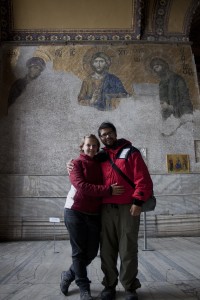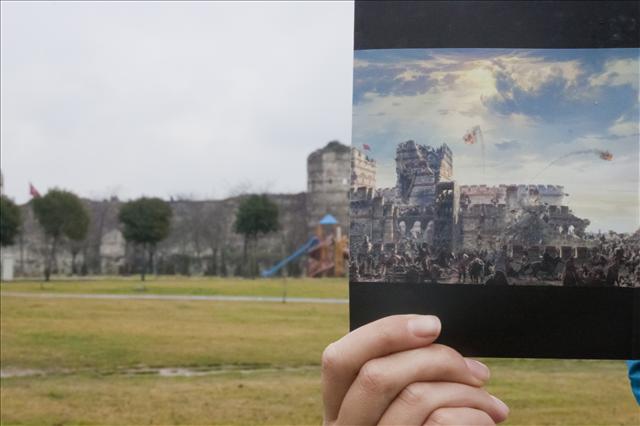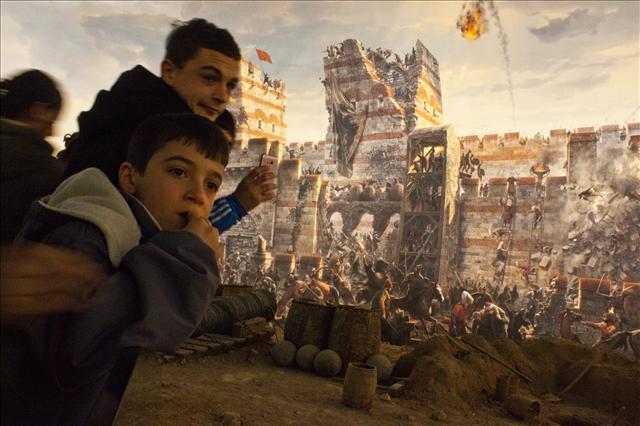Istanbul, Turkey, January 2012
Leer en Español
The month is April of 1453, a young sultan of only 21 years old by the name of Mehmed II leads a huge army of men determined to take the much desired city of Constantinople. A few months before the young brilliant military strategist ordered to built a fortress called Rumeli Hisari only 10 km east of the city. The reason, the fortress would allow him to cut the communication of the Byzantine Empire from acces in and out of the Black Sea, thus isolating the city of military aid from the west, creating a passage for his troops from Ankara and thereby formulate an excellent opportunity to surround the city and conquer it .
On the other hand King Constantine IX, then head of the city, knew what this new threat meant to the empire. So with the acces to the Black Sea closed and no aid comming from the Catholic Church. The King could only rely on the long and heavy chain that blocked the passage of vessels to the “Golden Horn” and a wall of several layers that had successfully defended before the city of various invasions to face his enemy.
“And all this suspense happened here,” I said to Annika while we observed the ruins of the huge wall surrounding what it once was the former Constantinople. As we walked toward the center where were going to find the the main museums and where I would see for my very first time the Asian continent.
A month later, to be exact on the night of May 29, 1453 after days and nights of attacking the impenetrable wall, the young Sultan sent the order that would capitalize his victory. Mehmed II, surrounded by the sound of military music that ran live looking to inspire his army, decided to concentrate all his firepower from his huge explosive cannons specially designed for this invasion to one location, the northwest side of the wall. And so it was that another military chapter was written on the books of history on how the Sultan broke the impenetrable walls and created a way into the city so that the Ottoman army could fulfill its purpose.
 “Can you believe that all this happened in this place Annika?” Again I yelled to her with much excitement and joy that Annika had no choice but to answer, “Yes, I do.” While we entered the Haya Sophia Museum.
“Can you believe that all this happened in this place Annika?” Again I yelled to her with much excitement and joy that Annika had no choice but to answer, “Yes, I do.” While we entered the Haya Sophia Museum.
I read that for three days after entering the city, the Ottoman army sacked the city looking to conserve for the Sultan all the riches that the Greeks wanted to take into exile while at the same time struck down those who still resisted the conquest. One of these men was King Constantine XI. It is said that he dressed in his gala uniform of war and died in the line combat bravely along his brave soldiers defending their city. Once the city was taken to safeguard the young sultan ordered all buildings in the city to be untouched because he wanted to preserve its greatness for himself and for the glory of the Ottoman Empire. An order in which we are all grateful even until this day. This was the reason why we owe the existence of this magnificent building on which we stand: The Haya Sophia Museum. This building, which previously had been a Byzantine Christian Church and on the order of the Sultan became a beautiful mosque is an impressive relic of humanity.
As you can see the museum is still in ongoing restoration of the walls that reveal its Christian past revealing the sacred images that commonly adorned the temples of the Byzantine Empire.”And you believe that Annika, all this happened here! Where we are standing!”, as we left the museum and headed to the new 1453 Panorama Museum located just opposite of the old city wall.
When Mehmed II took full control of the city, he sent a message alerting the former residents that were hiding between the the rubble of war. The message was overwhelming, it said that they could return to their own houses safely, no questions asked. The message also went to the former officials and bureaucrats assuring that the new administration would respect their rang and they would be treated as if nothing had happened to whoever wanted to return to the city. The order surprised not only his army but to all the readers who have read this part of the story (including myself ).And so gradually Mehmed II consolidated his conquest earning the respect of the people under its new name: Istanbul. The Ottoman Empire would take care of the city leaving it almost untouched from any other invasion, until its fall in 1922.
“Annika can you believe everything I have just said? All this happened here! “I told her just before entering the Museum Panorama 1453.This time Annika said nothing and listened carefully to the explanations coming from her audio guide of the museum. Then we went up to the room where the panoramic painting was. After looking at the increadible painting she turned around at me and said, “You’re right, you’re absolutely right! All this really happened here. I can see it and hear just right here. Now I know why you say that Istanbul is like a time machine. ”
Note to reader: The Fall of Constantinople not only meant the official end of the great Roman Empire, but also forced the Europeans to find new sea routes to reach Asia (via Istanbul it was no longer possible). Among them an expedition of a controversial explorer Christopher Columbus, who wanted to reach India by going West. So in a way Mehmed II somehow indirectly contributed to the discovery of the Americas.








Pingback: 14 Questions and Answers from Turkey | Tasting Travels
Pingback: Estambul: La Máquina de Tiempo | Tasting Travels